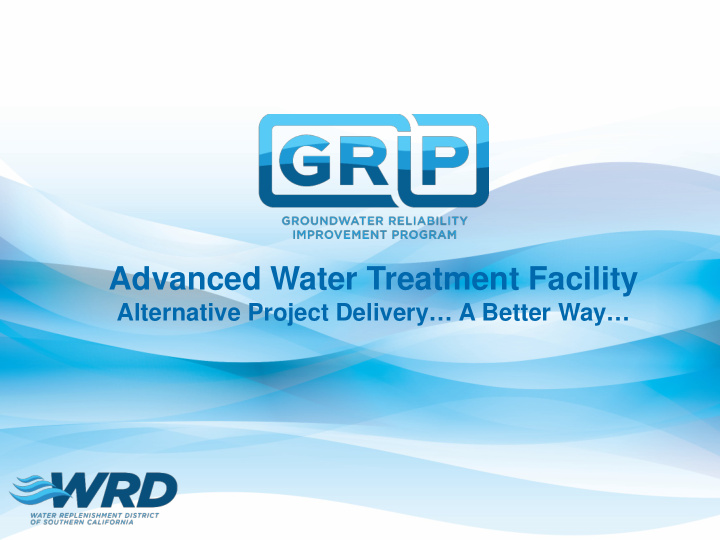



Advanced Water Treatment Facility Alternative Project Delivery… A Better Way…
Service Area = 420 Square Miles 43 Cities Population = 4 Million 720,000 acre feet used per year 40% Groundwater from local water wells 60% Imported water WRD supplements natural groundwater recharge
Water Independence Now Initiative • Goal to replace imported water with locally available water (e.g. recycled water) for aquifer replenishment. • Benefits of recycled water over imported water: increased reliability cost-effective locally controlled drought proof
Advanced Water Treatment Facility
Why Consider Alternative Project Delivery? • Prior DBB project was stalled • Schedule control • Limited staff • Desire to have more control • Future operational optionality • Price control • Master Plan and other project alignment(s)
D-B-B: What’s really the Difference? • Owner always owns the risk “Traditional” Design-Bid-Build (DBB) Owner
D-B-B: What’s really the Difference? • Owner always owns the risk “Traditional” Design-Bid-Build (DBB) • Transferred/assigned risk (myth versus reality) • Owner must be willing to accept consequences for decision making Owner Builder Designer
D-B-B: What’s the really the point? • Owner always owns the risk “Traditional” Design-Bid-Build (DBB) • Transferred/assigned risk (myth versus reality) • Owner must be willing to accept consequences for decision making Owner • Does partnering under D-B-B really + Builder make a difference? Designer 3 rd Party CM
Key Points: Other Delivery Options There are multiple forms of • allowable alternative project delivery formats • Each form has strengths and weaknesses • Owner must pick the best approach for individual project needs
Alternative Project Delivery Methods “Progressive” “Lump Sum” “Traditional” “CM@Risk” Design-Build-Operate Design-Build-Operate Design-Bid-Build Construction Management (GMP) (LS) (DBB) at Risk Owner Owner Owner Owner Builder CM Designer Designer Local Subconsultants Local Subcontractors Design Design Builder Builder Operator Operator Local Subconsultants/ Local Subconsultants/ Subcontractors Subcontractors Traditional Delivery Alternative Delivery
Key Points: Prescriptive vs. Non-Prescriptive “Lump Sum” Design-Build-Operate (LS) Owner Lump Sum Design-Build-Operate: “Performance-based” or “Prescriptive” Design Builder Operator Local Subconsultants/ Subcontractors
Key Points: Prescriptive vs. Non-Prescriptive “Progressive” “Lump Sum” Design-Build-Operate Design-Build-Operate (GMP) (LS) Owner Owner Progressive Lump Sum Design-Build-Operate: Design-Build-Operate: = “Qualifications-based” “Performance-based” or or “Non-Prescriptive” “Prescriptive” Maximum flexibility for Owners Design Design Builder Builder Operator Operator Local Subconsultants/ Local Subconsultants/ Subcontractors Subcontractors
Key Points: Managed Risk Owner enjoys maximum flexibility/opportunity to • collaborate on permitting/design • Adds flexibility for budget constraints • Owner has multiple “off-ramps” in case of permitting issues or if GMP can’t be successfully negotiated • Progressive (non-prescriptive) Design-Build-Operate reduces the time it takes to select a Design-Builder- Operator • Procurement can run in tandem with other critical path efforts (e.g., permits) Accelerates concept development evaluation and • pricing
Key Points: Managed Risk
Key Points: Managed Risk
Key Points: Managed Risk • Accurate risk assignment • Establishing rules of engagement • Create environment for collaboration and innovation
Key Points: Owner’s Choosing APD 70% 60% Water/Wastewater Projects 50% 40% 30% 20% 10% 0 2010 2011 2012 2013 2014 2015 2016 APD Traditional DBB
Key Points: APD Saves Money
Key Points: Collaboration Encourages Innovation
Progressive D-B-O: A Better Way? “Progressive” Key Advantages Design-Build-Operate (GMP) • Invest in Projects not Procurements • Schedule • Progressive costs estimates address Owners’ financing challenges Owner • Better opportunities for local subconsultant and subcontractor support • Owner is completely engaged and Design part of collaborative project delivery Builder Operator team Local Subconsultants/ Subcontractors
Keys to Achieving Success • Need a project champion/advocate • Stakeholder buy-in an absolute must • Must be willing to share risk and work harder/differently • OE/OA is part of the overall team – Extension of staff and not a “first” line-of-defense – Provide programmatic management and technical advisory services – Collocation is critical to facilitating the collaborative process – Must be a facilitator and team leader
Benefits of APD (D-B-O) • Selection methodology focuses on traditional evaluation criteria – Primarily qualifications based allowing owner to select team that offers best innovations, approach, and value – Excellent approach when considering cost, schedule, and operational impacts associated with various process and design configurations – Selection criteria can be tailored to support owner’s project-specific needs • More flexibility after design-builder-operator selection – Supports a “best value” approach where design-builder-operator works hand-in-hand with owner to make critical design and process decisions – Owner can provide input on preferred specialty firms/manufacturers/equipment providers • Design-builder-operator can still secure bids to ensure competitive pricing • Easier to integrate PLA and monitor labor compliance
For more information visit www.wrd.org
Recommend
More recommend